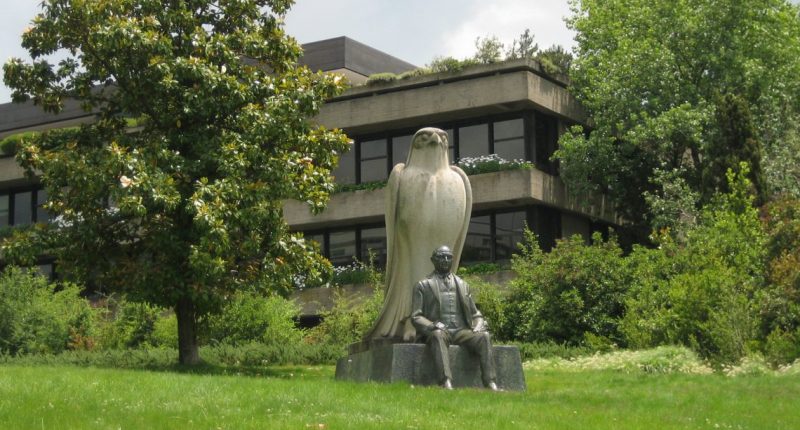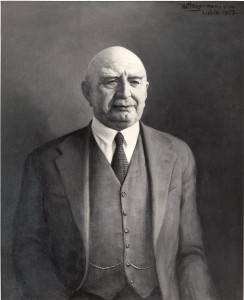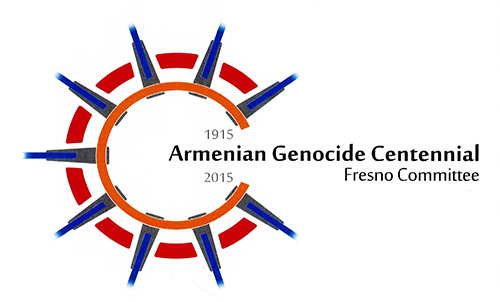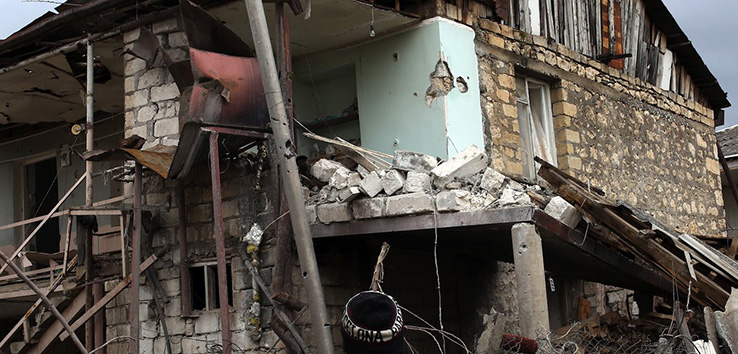“As of the end of 1971 the funds distributed by the Calouste Gulbenkian Foundation to the various Armenian organizations, religious, educational, scholarships, amounted to $20 million”
OFFICIAL REPORT
The Great Benefactor
Calouste Gulbenkian, born in 1869 in Constantinople, gained fame since 1910 as he followed the steps of his mentor Alexander Mantashian of Tbilisi, a giant in the petroleum industry. His father died early in 1893, and his mother in 1908. The family name Gulbenkian is derived from the surname of Prince Vart Rshtuni, the father of the 7th century Prince Theodoros Rshtuni, who defended Armenia against the Arab incursions. Following his graduation from the Armenian grade school in Kadikeoy, Calouste was admitted at Oxford University in England, and graduated as an engineer writing his first essay on the petroleum mines of Baku. It was published in a French magazine. Calouste married Nevart Yessayan in London and they became the parents of Noubar and Rita.
Since 1895 Calouste Gulbenkian was engaged in the petroleum industry working with the well-known companies of England and Holland, and in 1900 he became the pioneer of the discovery of a vast mine in Mesopotamia. During the following decade, already a British citizen, Calouste became one of the founders of Turkish Petroleum Company. It was through his skill and wisdom that he soon attained the heights of international and national benevolence worldwide.
His Fame and Bequest
During the first half of the 20th century Calouste Gulbenkian proved to be a leading figure in Lisbon, Portugal, where he established his residence and his future Foundation since 1942. According to his bequest, the Calouste Gulbenkian Foundation was established by the Portuguese government in 1956 as a State Foundation, based on his monumental wealth of $500 million, accumulated from his previous investments. The Foundation aimed at benevolence to assist the country’s educational, scientific, and publication endeavors, mostly non-Armenian.
In honor of this great benefactor, Armenians should gratefully acknowledge that the state decree dated July 18, 1956, included a section reserved to the “Armenian Affairs” that reached immensely to the perpetual and lasting assistance which the Calouste Gulbenkian Foundation granted to the various Armenian churches, schools, scholarships, publications, and philanthropic needs worldwide. Some of the following calculated distributions marked below, will give a general idea on the perpetual and lasting assistance the Foundation has granted, and continuously granting as of this day. Of special degree the widespread scholarships over the years, numerous indeed, testify the value of this great Foundation for which beneficiaries of the past and present generations are most grateful.
Gulbenkian Library, Jerusalem
Much earlier than the establishment of the Foundation, in July of 1931, the Gulbenkian Library in the Patriarchate of Jerusalem was built in honor of Patriarch Yeghishe Tourian on the 50th anniversary of his ordination to the priesthood in 1929. Hearing about the plans, on his official visit to Paris as the Pontifical Legate of H.H. Catholicos of All Armenians Kevork V, the Primate of Egypt Archbishop Torkom Koushagian had met philanthropist Calouste Gulbenkian in 1929 and secured “the entire cost of the monumental building of the Library in memory of the benefactor’s parents Sarkis and Dirouhi”.
The Executive Board of the Brotherhood of the Patriarchate had formed a committee to oversee the project, as they soon became aware of the gift of the full cost incurred from Archbishop Koushagian. Upon hearing the good news, Patriarch Yeghishe Tourian wrote a letter of appreciation, himself designating the name of the Library as “Gulbenkian Library dedicated to the memory of the benefactor’s parents Sarkis and Dirouhi, with additional funds possibly raised by the Armenian community for publications,” thus revising the initial honor of his own anniversary. The Patriarch passed away in April of 1930. The following year he was succeeded by Patriarch Torkom Koushagian who inaugurated the elegant Library in July, 1931.
As an eye-witness who has visited the Patriarchate twice, I wish to state that the monumental structure, purely in Armenian traditional style, comprises of two stories, and from the exterior and the interior is an impressive house of learning. The main hall at the center is surrounded by the two-level balconies overseeing the hall with iron cabinets and shelves carrying tens of thousands of books, with eight reading rooms on the sides evenly opened for study. Soon the entire personal library of the late Patriarch Tourian was transferred in the new building, so were the valuable correspondences and the ancient archives of the Armenian Patriarchate of Constantinople shipped by the orders the then Patriarch Zaven Der Yeghiayan just before WWI.
Armenian Appropriations
During 1956-1969 the Gulbenkian Foundation in general has allocated some $135 million basically to Portuguese institutions, including a portion to the Armenian institutions, at the time the Foundation had opened its central offices and a museum where some 3,000 personal artifacts of the benefactor are treasured. In addition, in 1960 the section of the “Armenian Affairs” had made significant appropriations of which the following represent only a few samples in given figures taken from the Foundation’s Report that appeared in the monthly SION of Jerusalem Patriarchate.
From July to December 1960 the allocations to Armenian institutions represented $550,000 for the six months, totaling the amount to $750,000 for the entire year. Reports show distributions of those allocations for renovation of 56 Armenian school buildings, assistance to the school in Detroit, Michigan, an allocation to the Armenian Church Diocese of Iraq for the building of an additional floor above the St. Tarkmanchats School, as well as to the Mekhitarist School in Alexandria, Egypt. The same year 55 Armenian schools in Lebanon were the beneficiaries of grants for school furnishing and installation, in addition to scholarships for the Armenian youths in Lisbon, and an annual scholarship of $150,000 to the students in the Diaspora universities over four years, totaling $500,000.
$20 Million Armenian Grants
At the end of 1971 Armenian institutions at large had benefited from the Calouste Gulbenkian Foundation no less that $20 million over the years. A decade earlier, a report from Lisbon dated January 1961 and published in the monthly SION, included in the grand total $2,100,000 for the year ending December, 1959. For sure the Armenians are gratefully indebted to this great benefactor for leaving behind a monumental Foundation posthumously, no less important than the AGBU, whose second President Calouste Gulbenkian was elected, succeeding the founding President Boghos Noubar Pasha. However, his tenure was very short and disappointing for him as he resigned, given the primitive initiatives and the slow motion of the AGBU in its initial stages. We believe that the above scant numbers of allocations to the Armenian educational and religious institutions speak for themselves giving us an idea at a glance for the past and future benevolence to the Armenian nation.
Holy Resurrection Cathedral
During the initial years of his patriarchate of Jerusalem, Patriarch Yeghishe Derderian faced a major task in the costly renovation of the Holy Resurrection Cathedral of Jerusalem from 1963. The estimated cost being 900,000 Eng. Pounds, the three denominations, the Greek, Latin, and Armenian Patriarchates, who traditionally are equally the rightful guardians of the holy sites, were responsible to share the cost among them, 300,000 each. In October 1963, the Catholicos of All Armenians H.H. Vasken I was invited for a national fund raising meeting at which time a petition was sent to the Calouste Gulbenkian Foundation to assist. The request by His Holiness on behalf of the Patriarchate was well received by the Foundation who agreed to donate the one third of the Armenian share (100,000), distributed on six years, given the duration of the renovations. The Foundation also recommended that the Armenian communities should come together to meet the balance.
It took six years to complete the renovations, upon which the editor of SION expressed gratitude on behalf of the Patriarchate and the Armenian nation for the initiative taken by the Lisbon-based Calouste Gulbenkian Foundation.











